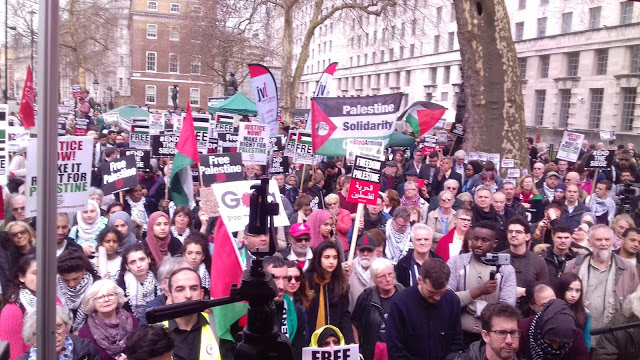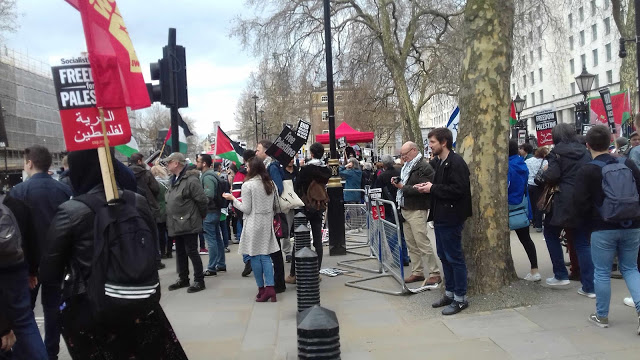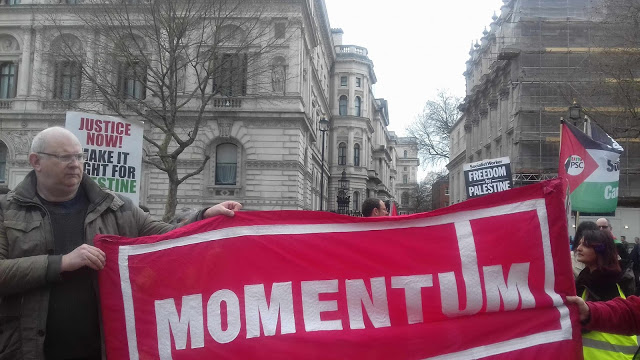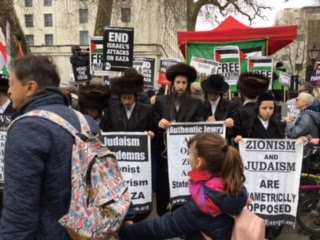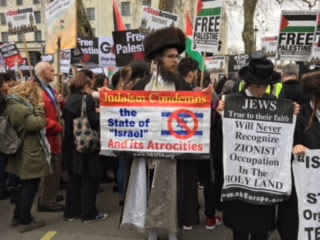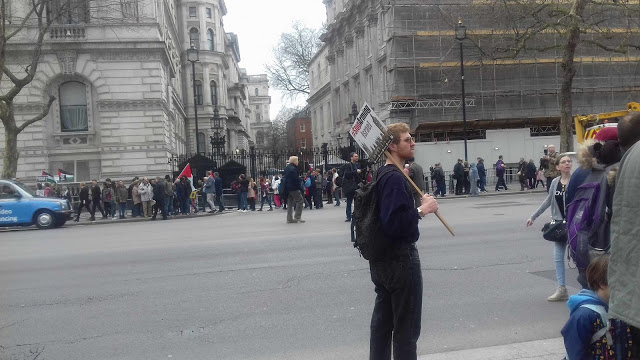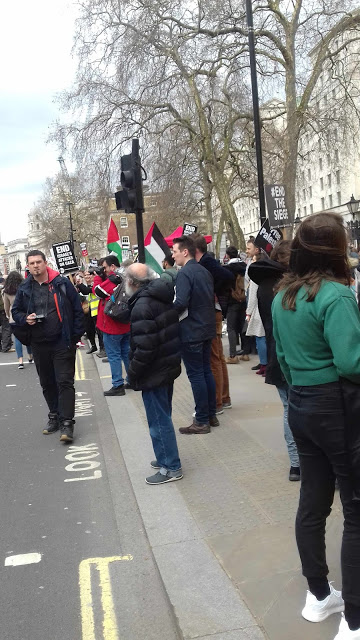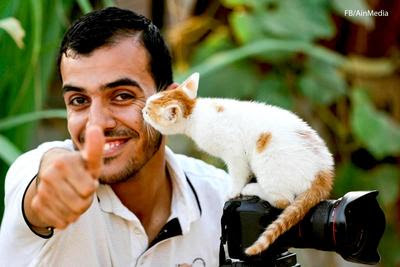Today
over 2,000 demonstrators gathered outside Downing Street in Whitehall to make
their voice heard about Israel’s massacre of unarmed demonstrators in
Gaza. Faced with a hermetically sealed
siege for over a decade, a lack of freshwater, electricity, medical supplies
and food people have taken to protesting at the border fence of Gaza demanding
the right to return to where they came from – Israel.
over 2,000 demonstrators gathered outside Downing Street in Whitehall to make
their voice heard about Israel’s massacre of unarmed demonstrators in
Gaza. Faced with a hermetically sealed
siege for over a decade, a lack of freshwater, electricity, medical supplies
and food people have taken to protesting at the border fence of Gaza demanding
the right to return to where they came from – Israel.
Israel’s
response has been, as shown below, the normal one which one expects. 27 people have been murdered and over a
thousand have been injured by live gunfire.
This despite the fact that all those killed or injured are within concentration
camp Gaza.
response has been, as shown below, the normal one which one expects. 27 people have been murdered and over a
thousand have been injured by live gunfire.
This despite the fact that all those killed or injured are within concentration
camp Gaza.
It
is testimony to the cynicism of the West that there has been no response to
these killings by the British government.
Jeremy Corbyn sent a message to the demonstration but we fear that he is
going to go next week to appease the Board of Deputies of British Jews and the Jewish
Leadership Council both of which support Israel’s massacre, blaming it on the Palestinians
themselves.
is testimony to the cynicism of the West that there has been no response to
these killings by the British government.
Jeremy Corbyn sent a message to the demonstration but we fear that he is
going to go next week to appease the Board of Deputies of British Jews and the Jewish
Leadership Council both of which support Israel’s massacre, blaming it on the Palestinians
themselves.
There
was a contingent from Brighton and Hove there today, including some of us from
Momentum. Below are reports on the
demonstrations in Gaza and also a report on the murder yesterday of a Palestinian
journalist in Gaza.
was a contingent from Brighton and Hove there today, including some of us from
Momentum. Below are reports on the
demonstrations in Gaza and also a report on the murder yesterday of a Palestinian
journalist in Gaza.
Tony
Greenstein
Greenstein
The Nakba is not a just a memory, it is an ongoing
reality. We can accept that we all must eventually die; in Gaza, the tragedy is
that we don’t get to live.
reality. We can accept that we all must eventually die; in Gaza, the tragedy is
that we don’t get to live.
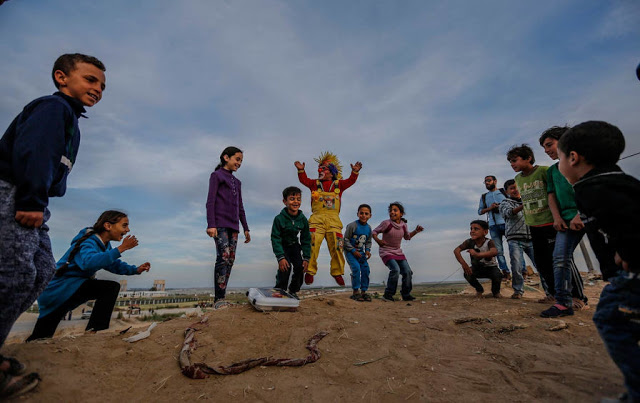 |
| A Palestinian clown entertains Palestinian refugee children at the tent city protest near the border with Israel, in Gaza, April 2, 2018. (Mohammed Talatene / picture-alliance / dpa / AP Images) |
Khan Younis—Over the past eight days, tens of thousands of
protesters in Gaza have breathed life into a place that is slowly being
depleted of it. We have come together, chanting and singing a lullaby we’ve all
longed for—“We will return”—bringing all that we have left to offer in an
attempt to reclaim our right to live in freedom and justice. Despite our
peaceful marches, we have been met with and clouds of tear gas and live fire
from Israeli soldiers. Unfortunately, this is not new to Palestinians in Gaza,
who have lived through many wars and a brutal siege and blockade.
protesters in Gaza have breathed life into a place that is slowly being
depleted of it. We have come together, chanting and singing a lullaby we’ve all
longed for—“We will return”—bringing all that we have left to offer in an
attempt to reclaim our right to live in freedom and justice. Despite our
peaceful marches, we have been met with and clouds of tear gas and live fire
from Israeli soldiers. Unfortunately, this is not new to Palestinians in Gaza,
who have lived through many wars and a brutal siege and blockade.
Gaza is home to almost 1.9 million people, of which 1.2 million are
refugees who were expelled from their homes and land during the establishment
of Israel 70 years ago, known as the Nakba (catastrophe) to Palestinians. Since
the beginning of the siege almost 11 years ago, the task of simply surviving
each day has proved to be a challenge. To merely wake up and have access to
clean water and electricity is now a luxury. The siege has been particularly
hard on young people, who suffer from a 58 percent
unemployment rate. What’s worse is that all of this is a result of Israeli
policy, which can be changed. This harsh and difficult life does not have to be
the reality for Gaza.
refugees who were expelled from their homes and land during the establishment
of Israel 70 years ago, known as the Nakba (catastrophe) to Palestinians. Since
the beginning of the siege almost 11 years ago, the task of simply surviving
each day has proved to be a challenge. To merely wake up and have access to
clean water and electricity is now a luxury. The siege has been particularly
hard on young people, who suffer from a 58 percent
unemployment rate. What’s worse is that all of this is a result of Israeli
policy, which can be changed. This harsh and difficult life does not have to be
the reality for Gaza.
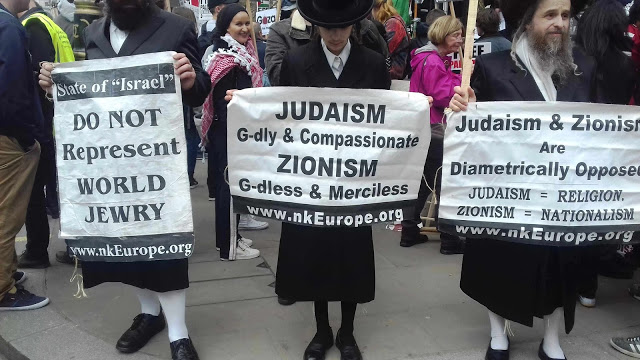 |
| Members of the Orthodox Anti-Zionist Sect Neturei Karta |
It is as though displacing us was not enough; it’s as if the entire
memory of Palestinian refugees must be contained and erased.
memory of Palestinian refugees must be contained and erased.
Fishermen cannot go beyond six nautical miles, making it a challenge to
gather enough fish to sustain their families. After Israel’s wars on Gaza, in
2008-09 and then again in 2012 and 2014, and all the killings that happened in
between, the people here aren’t even afforded the chance to rebuild, as Israel
has tightened its hold on the entry of construction materials. The state of
hospitals is alarming, and patients are rarely given the chance to seek
treatment outside. This isn’t even to mention the perpetual state of darkness
we live under, with barely any electricity or clean water. It is as though
displacing us was not enough; it’s as if the entire memory of Palestinian
refugees must be contained and erased.
gather enough fish to sustain their families. After Israel’s wars on Gaza, in
2008-09 and then again in 2012 and 2014, and all the killings that happened in
between, the people here aren’t even afforded the chance to rebuild, as Israel
has tightened its hold on the entry of construction materials. The state of
hospitals is alarming, and patients are rarely given the chance to seek
treatment outside. This isn’t even to mention the perpetual state of darkness
we live under, with barely any electricity or clean water. It is as though
displacing us was not enough; it’s as if the entire memory of Palestinian
refugees must be contained and erased.
I was born in Rafah refugee camp in Gaza. My parents are from the city
of Ramle, in what is now known as Israel. Like most Palestinian refugees, I
heard the stories from my older family members about being brutally displaced
from their homes during the Nakba. No matter how many decades pass, they,
like hundreds of thousands of others, are never able to forget the horrors they
witnessed during their dispossession and all the violence and pain that came
with it.
of Ramle, in what is now known as Israel. Like most Palestinian refugees, I
heard the stories from my older family members about being brutally displaced
from their homes during the Nakba. No matter how many decades pass, they,
like hundreds of thousands of others, are never able to forget the horrors they
witnessed during their dispossession and all the violence and pain that came
with it.
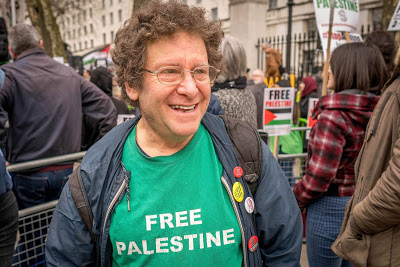 |
| A rare appearance by yours truly |
I have never seen my family’s home in Ramle, and my children have never
seen anything beyond the confines of Gaza and the siege. With my eldest just 7
years old and my youngest 2, they do not know a reality beyond the sound of bombs,
the darkness of night with no electricity, the inability to travel freely—or
the fact that these things are not normal. Nothing about life in Gaza is
normal. The Nakba is not a just a memory, it is an ongoing reality. And while
we can reconcile that we all must eventually die, in Gaza the tragedy is that
we don’t get to live.
seen anything beyond the confines of Gaza and the siege. With my eldest just 7
years old and my youngest 2, they do not know a reality beyond the sound of bombs,
the darkness of night with no electricity, the inability to travel freely—or
the fact that these things are not normal. Nothing about life in Gaza is
normal. The Nakba is not a just a memory, it is an ongoing reality. And while
we can reconcile that we all must eventually die, in Gaza the tragedy is that
we don’t get to live.
The last two Fridays, we stood against all the powers telling us to
break and die in silence and decided to march for life.
break and die in silence and decided to march for life.
It is in spite of this harsh reality that we endure. The last two
Fridays, we stood against all the powers telling us to break and die in silence
and decided to march for life. It is a protest of a people who want nothing
more than to live in dignity.
Fridays, we stood against all the powers telling us to break and die in silence
and decided to march for life. It is a protest of a people who want nothing
more than to live in dignity.
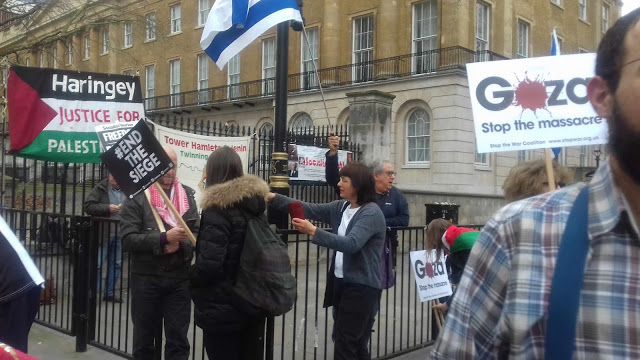 |
| A lonely Jonathan Hoffman, ex-Vice Chair of the Zionist Federation before he was booted out – he was later joined by someone else |
In 2011, Palestinians marched near the borders from Syria, Lebanon,
Jordan, Gaza, and the West Bank. Some were killed, others made it past the
border and were arrested by Israeli soldiers. But long before then, in 1976,
Palestinians protested the expropriation of their lands by Israel in what later
became known as Land Day. Six Palestinians were killed then, and 42 years later
Israel is still resorting to deadly violence to prevent refugees from
returning, killing at least 25 Palestinians in Gaza since last Friday. Those
human beings dared to dream beyond the alleyways of the refugee camps; they had
a vision of a home they never had the chance to see.
Jordan, Gaza, and the West Bank. Some were killed, others made it past the
border and were arrested by Israeli soldiers. But long before then, in 1976,
Palestinians protested the expropriation of their lands by Israel in what later
became known as Land Day. Six Palestinians were killed then, and 42 years later
Israel is still resorting to deadly violence to prevent refugees from
returning, killing at least 25 Palestinians in Gaza since last Friday. Those
human beings dared to dream beyond the alleyways of the refugee camps; they had
a vision of a home they never had the chance to see.
I have worried for our safety as we came out in the thousands to what
Israel deems a “no-go zone.” I have thought about the consequences. As I stood
with my family near the Return March square in eastern Khan Younis, we were all
tear-gassed, including my children. I was pained to see the innocence of
childhood being tainted by such a traumatizing experience. But what many people
fail to recognize is that whether we are in our homes or protesting in the
fields, we are never truly safe in Gaza, nor are we truly alive. It is as
though our entire existence, and dreams of ever returning home and living in
dignity, must be hidden in the dark.
Israel deems a “no-go zone.” I have thought about the consequences. As I stood
with my family near the Return March square in eastern Khan Younis, we were all
tear-gassed, including my children. I was pained to see the innocence of
childhood being tainted by such a traumatizing experience. But what many people
fail to recognize is that whether we are in our homes or protesting in the
fields, we are never truly safe in Gaza, nor are we truly alive. It is as
though our entire existence, and dreams of ever returning home and living in
dignity, must be hidden in the dark.
However, this year, after Trump’s recognition of Jerusalem as the
capital of Israel and the possibility of making what he called the “deal of the
century,” Palestinians have felt an imminent threat to the legal right of
return of refugees, despite its being enshrined in UN Resolution 194. It is a
collective worry that our rights as refugees are in serious jeopardy, and we
must resist it in an innovative, unified, revolutionary way—one that exists
outside the parameters of negotiations and factionalism, to place pressure on
Israel to reclaim our rights.
capital of Israel and the possibility of making what he called the “deal of the
century,” Palestinians have felt an imminent threat to the legal right of
return of refugees, despite its being enshrined in UN Resolution 194. It is a
collective worry that our rights as refugees are in serious jeopardy, and we
must resist it in an innovative, unified, revolutionary way—one that exists
outside the parameters of negotiations and factionalism, to place pressure on
Israel to reclaim our rights.
For the past 70 years, Israel has been in a perpetual state of
displacing and humiliating Palestinians. We saw it happen in 1948, and again in
1967, and now we are still witnessing it, with the growth of settlements. As
Israel pushes Palestinians out, it brings in new immigrants from around the
world and settles them on lands stolen from Palestinians, in violation
of international law. Yet Israel continues to be emboldened by a lack of
pressure from the international community, and by the support of the Trump
administration, so settlements continue to expand relentlessly.
displacing and humiliating Palestinians. We saw it happen in 1948, and again in
1967, and now we are still witnessing it, with the growth of settlements. As
Israel pushes Palestinians out, it brings in new immigrants from around the
world and settles them on lands stolen from Palestinians, in violation
of international law. Yet Israel continues to be emboldened by a lack of
pressure from the international community, and by the support of the Trump
administration, so settlements continue to expand relentlessly.
Israel would have the world believe that Palestinians willingly left our
homes and chose this life of degradation, without basic human rights, and that
we brought it on ourselves.
homes and chose this life of degradation, without basic human rights, and that
we brought it on ourselves.
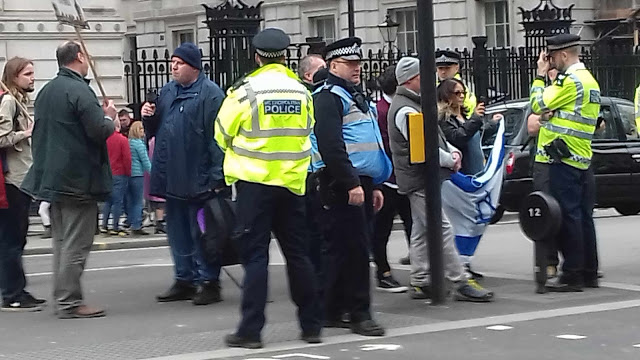 |
| Paul Besser – (in woolly blue hat) – former Intelligence Chief of neo-Nazi Britain First |
Today, the Palestinians of Gaza are attempting to break the chains that
Israel has tried so hard to force us into. We are unarmed demonstrators
confronting heavily armed soldiers with peaceful protest. As a result, it
is difficult for Israel to smear us and justify its brutal violence, and the
world is faced with the reality that innocent civilians are being killed just
for exercising their right to protest peacefully. The excuses Israel uses to
justify its policies toward the Palestinians are slowly losing their
effectiveness, as people around the world are increasingly realizing that the
true face of Israel is that of a brutal apartheid regime.
Israel has tried so hard to force us into. We are unarmed demonstrators
confronting heavily armed soldiers with peaceful protest. As a result, it
is difficult for Israel to smear us and justify its brutal violence, and the
world is faced with the reality that innocent civilians are being killed just
for exercising their right to protest peacefully. The excuses Israel uses to
justify its policies toward the Palestinians are slowly losing their
effectiveness, as people around the world are increasingly realizing that the
true face of Israel is that of a brutal apartheid regime.
Despite the calculated
violence and targeting of unarmed protesters by Israel, with our Great
Return March, Palestinians in Gaza are stating loudly and clearly that we are
still here. For Israel, it is our identity that is our crime, but we are
celebrating the very identity that Israel tries to criminalize. People from all
walks of life are joining the march. Artists are contributing with the traditional
dabke dance, intellectuals are organizing reading circles, entertainers
are dressing as clowns and playing with children. What has been most striking
is the young, living and playing, their laughter the greatest protest of all.
violence and targeting of unarmed protesters by Israel, with our Great
Return March, Palestinians in Gaza are stating loudly and clearly that we are
still here. For Israel, it is our identity that is our crime, but we are
celebrating the very identity that Israel tries to criminalize. People from all
walks of life are joining the march. Artists are contributing with the traditional
dabke dance, intellectuals are organizing reading circles, entertainers
are dressing as clowns and playing with children. What has been most striking
is the young, living and playing, their laughter the greatest protest of all.
The UN warned that Gaza may be uninhabitable
in just two years. Resisting the fate that Israel has planned for us, we
are fighting back peacefully with our bodies and our love for life, appealing
to the justice that remains in the world.
in just two years. Resisting the fate that Israel has planned for us, we
are fighting back peacefully with our bodies and our love for life, appealing
to the justice that remains in the world.
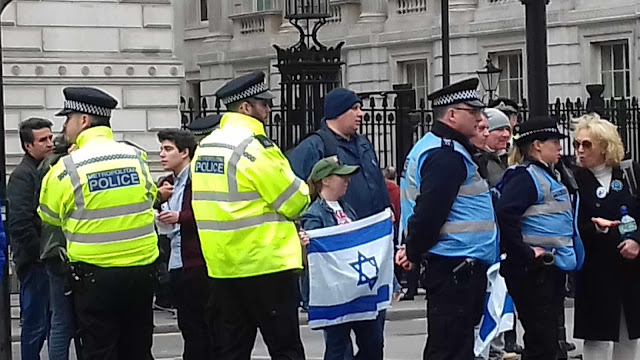 |
| Paul Besser of neo-Nazi Britain First and Gemma Sheridan (holding flag) of fascist Jewish Defence League |
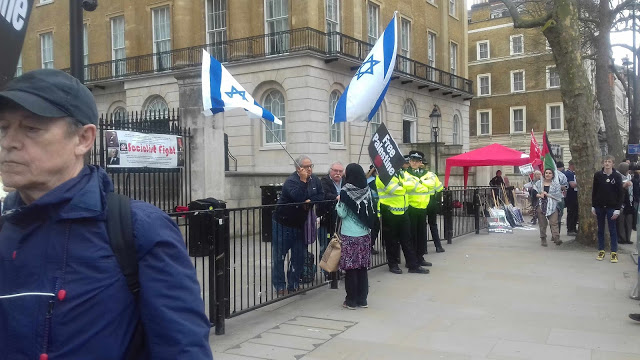 |
| Jonathan Hoffman and Richard Galber |
Ahmad Abu
RtemahAhmad Abu Rtemah is an independent Gaza-based writer, social-media
activist, and one of the organizers of the Great Return March.
RtemahAhmad Abu Rtemah is an independent Gaza-based writer, social-media
activist, and one of the organizers of the Great Return March.
PRESS STATEMENT
ISSUED BY
KWARA KEKANA ON BEHALF OF BDS SOUTH AFRICA
KWARA KEKANA ON BEHALF OF BDS SOUTH AFRICA
07 April
2018 |
2018 |
Yesterday, Friday 6th April, Israeli snipers shot and killed 30 year old
Palestinian photo journalist Yaser Murtaja (click here for news article).
Murtaja was
hit despite wearing a blue flak jacket marked with the word “press”,
discerning him as a journalist (click here for photo, warning graphic content).
hit despite wearing a blue flak jacket marked with the word “press”,
discerning him as a journalist (click here for photo, warning graphic content).
Murtaja was
born in the Palestinian Gaza Strip, often described as a prison camp
(where Israel controls what and who is allowed in and what and who is allowed
out). It’s the worlds most densely populated piece of land (25km by 6km with
over 2 million people).
born in the Palestinian Gaza Strip, often described as a prison camp
(where Israel controls what and who is allowed in and what and who is allowed
out). It’s the worlds most densely populated piece of land (25km by 6km with
over 2 million people).
Last month
Yaser posted a picture of Gaza taken by a drone and said that he hoped to
one day take such a photo from the sky instead of from the ground (click here). Israel unfortunately also controls the
airspace above Gaza. Murtaja never got the opportunity to take the photo or to,
even once, leave Gaza.
Yaser posted a picture of Gaza taken by a drone and said that he hoped to
one day take such a photo from the sky instead of from the ground (click here). Israel unfortunately also controls the
airspace above Gaza. Murtaja never got the opportunity to take the photo or to,
even once, leave Gaza.
Palestinian
media analyst Nour Odeh has described Murtaja as “a beautiful soul and a gifted
journalist [who] dedicated his short-lived career to telling his people’s
story, showing their pain but also their joy, & dreams. His friends and
colleagues mourn him with sorrow”. Our condolences go out from South
Africa to the friends, family and media colleagues of Yaser Murtaja. Hamba
kahle, Yaser.
media analyst Nour Odeh has described Murtaja as “a beautiful soul and a gifted
journalist [who] dedicated his short-lived career to telling his people’s
story, showing their pain but also their joy, & dreams. His friends and
colleagues mourn him with sorrow”. Our condolences go out from South
Africa to the friends, family and media colleagues of Yaser Murtaja. Hamba
kahle, Yaser.
In addition
to Murtaja, Israeli snipers also shot 6 other journalists and killed two Palestinian
teenagers Mohammed Madi and Alaa Azamli. In total Israel killed 9 unarmed
Palestinians yesterday (6 April) and 30 since last week Friday (30
March). Palestinians across the political and religious spectrum have been
gathering at weekly protests, dubbed the #GreatReturnMarch, which
is a 6 week series of demonstrations taking place along the border of Gaza
and Israel. Over 75% of the Palestinian people living in Gaza are refugees
whose homes are in Israel. The UN has demanded that Israel allow the
Palestinians refugees to return but Israel has refused.
to Murtaja, Israeli snipers also shot 6 other journalists and killed two Palestinian
teenagers Mohammed Madi and Alaa Azamli. In total Israel killed 9 unarmed
Palestinians yesterday (6 April) and 30 since last week Friday (30
March). Palestinians across the political and religious spectrum have been
gathering at weekly protests, dubbed the #GreatReturnMarch, which
is a 6 week series of demonstrations taking place along the border of Gaza
and Israel. Over 75% of the Palestinian people living in Gaza are refugees
whose homes are in Israel. The UN has demanded that Israel allow the
Palestinians refugees to return but Israel has refused.
BOYCOTT,
DIVESTMENT AND SANCTIONS AGAINST ISRAEL IN SOUTH AFRICA (BDS SOUTH AFRICA)
DIVESTMENT AND SANCTIONS AGAINST ISRAEL IN SOUTH AFRICA (BDS SOUTH AFRICA)
Posted in Blog
